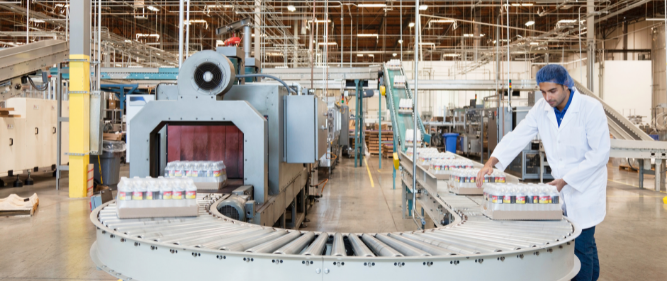Historically, most food and beverage manufacturers have used some combination of production strategies to develop their products, but recent supply chain disruptions and consumers’ desire for variety are forcing many to rethink their approach.
Make to stock (MTS) is a traditional “build-ahead” production strategy in which manufacturing plans are based upon sales forecasts and/or historical demand. A company using this approach would estimate how many orders its products could generate, and then supply enough stock to meet those orders.
Make to order (MTO), on the other hand, is a production approach in which products are not made until a confirmed order is received. This typically allows consumers to purchase products customized to their specifications.
In today’s food and beverage industry, we’re seeing more balance shifting to the MTO approach as companies increasingly seek out ways to optimize manufacturing costs — and there are a lot of costs tied up in stocked inventory. After all, if low demand for a particular product outpaces its shelf life, you’re now throwing away money in the form of spoiled inventory.
But make-to-order production requires specific planning and increased changeovers, so if you’re adding or increasing MTO processing, let’s review what you need to know.
Changeover efficiency is paramount
The MTS approach is more predictable: it operates under the assumption that you have a specific inventory to fill and repeats the process accordingly on a schedule.
Since MTO production is subject to the fluctuations of customer demand, it means more frequent changeovers to produce various SKUs whenever needed. As changeovers increase, changeover time becomes more significant.
An MTS operation may only conduct changeovers every few weeks, in which case a three-hour changeover time, while not necessarily ideal, isn’t very consequential.
Now imagine an MTO-driven facility that conducts changeovers much more frequently. Each minute of each changeover now carries more weight, because the changeovers themselves have more opportunities to set your production efficiency back. That’s why optimizing changeovers is critical in make-to-order production.
One way to streamline changeovers is to schedule packaging lines to run as you make product, so that packaging can continue as you shut down the production line for cleaning. Ideally, by the time packaging is back down, processing is ready to ramp back up on a new SKU. Of course, how this looks will vary from facility to facility, but the gist is the same: Ensure there is always a processing or packaging line running and minimize idle time during changeovers.
Just-in-time delivery and reducing finished product inventory
The shift to an MTO approach also marks a shift in how raw materials are sourced. Rather than maintaining a large inventory of raw ingredients in storage, making to order requires management of just-in-time (JIT) delivery, where the facility receives goods as close as possible to when they are actually needed.
With this inventory system, products can arrive a few hours or a day before the changeover, so keeping every ingredient in storage at all times isn’t sustainable, especially with a large number of SKUs. This is why proper planning is especially critical with an MTO approach. When a new SKU order arrives, a company needs access to real-time information in order to efficiently conduct a changeover and collaborate with more suppliers, if needed.
Pit stop mentality: communication and collaboration
With make-to-order production, open and frequent communication between departments is essential. If a facility’s maintenance team knows a particular changeover took three hours, but the scheduler estimated an hour and a half, they will always be behind on production if they don’t coordinate with each other.
Many facilities don’t maintain a detailed checklist for maintenance and operational aspects. The 5S methodology, developed in Japan, is considered one of the techniques that enabled just-in-time manufacturing. This system involves tracking performance and data visually to ensure coordination and that necessary parts are in the right place. One thing you don’t want is to be searching for equipment parts during a changeover.
Ultimately, the more frequently you’re conducting changeovers, the more efficient you need to be. Consider a pit stop in motorsports races: The pit crew is able to service the vehicle in a matter of seconds because each team member knows his or her exact responsibilities and everyone knows exactly how and where tools and parts are organized. This level of efficient collaboration should be the goal for food manufacturing facilities, too.
Analyzing your process and simulating changes
Optimizing your manufacturing process doesn’t necessarily mean starting from scratch or redesigning process equipment. At Stellar, we regularly evaluate facility operations and sit down with clients to brainstorm the best cost-effective solution for their plant.
A so-called “digital twin” software is a useful tool for understanding how certain changes to your processing approach will affect your operations and output. The real-time simulation software allows you to discover the best way to optimize your production runs via hypothetical trial and error. Facility managers can adjust certain parameters to simulate scenarios and see how those changes might impact operations. Of course, as with any algorithmic tool, a digital twin program is only as good as the data you provide it. We often help owners develop these models and train their personnel on how to use them.
In today’s market, there isn’t a dividing line between logistics and manufacturing. In order to thrive, keep up with evolving customer demand and strategically offer more SKUs, the logistics and manufacturing side of food processing must communicate and work together in order to be successful.
Interested in an assessment of your facility’s operations? Comment below or email me at foodforthought@stellar.net



